Trip Report – 29 December 2010 – 7 January 2011: Northern Fiordland National Park Summer Camp
This was a memorable gathering, thanks to wonderful places to botanise, the suitability and location of Boyd Creek Camp building and campsites, Mick Parsons’s organising, Sheelagh Leary’s catering, a generator, roasting stove, and botanical knowledge supplied by Otago participants, the use of the DOC visitor centre for a talk, the wholehearted involvement of everyone who came on this combined Wellington Botanical Society and Botanical Society of Otago field trip, coupled with mostly excellent weather.
Day 1, 30/12/10: Cascade Creek; Lake Gunn Nature Walk; Deer Flat
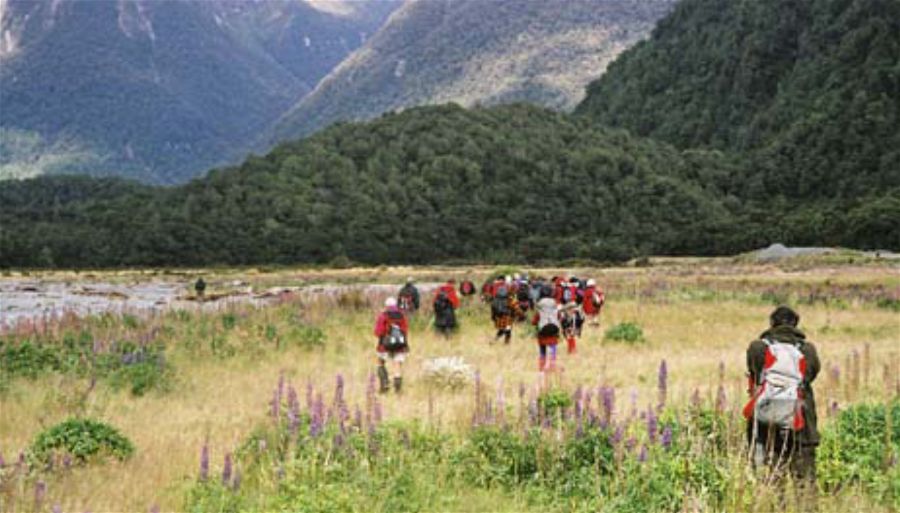 |
| BotSoccers on the flood plain of the Eglinton Valley, 30.12.2010. Photo: Julia Stace. |
A patch of bush, a bend, a swamp – you’ll know where you are. Yeah right.
The first day of the joint Wellington & Otago botanical societies’ summer camp was overcast and windy. We crossed Cascade Creek, dipping our toes into the waters of the Eglinton Valley botany. Plants seen on the bush edge immediately over the stream included
Aristotelia fruticosa and
Coprosma dumosa.
On the flood plain 1m high
Hebe odora, in flower, and
Halocarpus bidwillii, with cones, dotted the grassy swamp area. We saw
Geranium microphyllum with striking red and brown leaves,
Dracophyllum prostratum,
Androstoma (ex
Cyathodes)
empetrifolia,
Lycopodium fastigiatum and
Coprosma elatirioides, with
Carex coriacea and
C. sinclairii in flower. Underneath all the other plants grows
Blechnum penna-marina. A highlight for some was
Ranunculus multiscapus, and we did find
Schizeilema haastii and
Leucopogon fraseri. After crossing back over the swift stream, swollen by heavy rain, many photographed the two large purple berries on
Coprosma atropurpurea, and the single plant of
Scleranthus brockiei.
We then entered the ancient red beech forest,
Nothofagus fusca, nearby, to follow the Lake Gunn Nature Walk. The huge, moss-covered trees that had never been logged were impressive for their height, 40m+, their boles, and their buttress roots. The reserve was littered with wind-throws. The track looped past the end of Lake Gunn and its outlet, where the water level was still high and the flow strong. Excellent interpretation panels help overseas visitors take an interest in the plants, but many of the plants highlighted have had their names changed since the signage was installed.
Amongst the mosses on the forest floor were many clumps of flowering orchids e.g.
Gastrodia,
Pterostylis australis and
P. banksii. Trees other than red beech included
Raukaua simplex, Hall’s totara, (
P. cunninghamii),
Halocarpus biformis,
Olearia avicenniifolia,
Pseudopanax colensoi. Young pokaka, with all its diversity of foliage, grows near the water’s edge. Some people watched a fledgling robin, almost fatally caught in
Uncinia, free itself and fly off to preen.
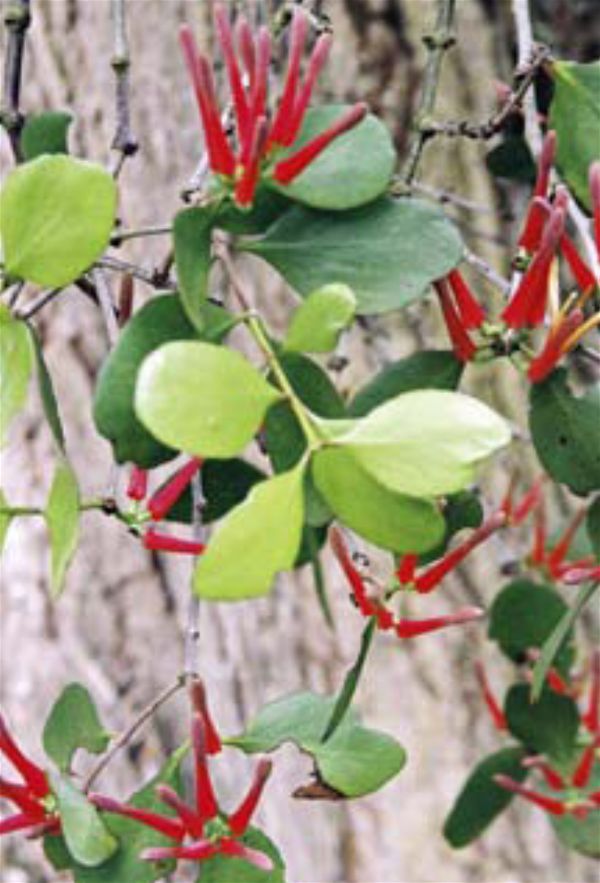 |
| Peraxilla colensoi, Deer Flat, 30/12/10. Photo: Julia Stace. |
About 3 p.m. we drove to the DOC campground at Deer Flat, another flat area on the same wide valley floor. Our instructions were to look for a patch of bush, a bend, and a swamp. In the Eglinton Valley, how specific is that! Several hard rock outcrops, known as kames, are found here. On one of the kame outcrops in the swamp, there were several uncommon species, e.g.
Melicytus flexuosus and
Carmichaelia petriei. Three black-fronted terns flew by.
Those who abandoned the idea of retaining dry feet were rewarded with discovery of the rare grass,
Deschampsia cespitosa, thriving in the flooded area nearby.
In the silver beeches,
Nothofagus menziesii, hung magnificent clumps of mistletoes,
Peraxilla tetrapetala and
P. colensoi in flower, right at camera height. Growing nearby in swampy ground, the
Coprosma propinqua shrubs held many tiny
Korthalsella clavata in berry. All these mistletoes were mature plants. We saw rodent traps nearby.
While returning to our vehicles people found
Olearia ilicifolia and
Hoheria glabrata flowering on the riverbank, and one of the Otago group finally was satisfied to find a plant of
Ranunculus ternatifolius.
As many people now record their plants of the day on digital cameras, the old system of the evening specimen table was abandoned, in part owing to concern over the restrictions of our collecting permit. Also the lack of space and lighting at night at the Boyd Creek camp contributed to its demise.
Mick Parsons & Julia Stace
Day 2, 31/12/10: Gertrude Saddle, Upper Hollyford Valley
Upper section: Leaving the valley floor, a host of new species appear including pineapple shrub (
Dracophyllum menziesii),
Coprosma serrulata,
Astelia nivicola and
A. petriei,
Chionochloa ovata – with lovely purple heads,
C. crassiuscula, with curled leaves,
Coprosma fowerakeri,
Olearia moschata and
Brachyglottis revoluta. Flower stalks of Haast’s carrot (
Anisotome haastii) stood up above the surrounding vegetation, and along with the white
Celmisia verbascifolia flowers, and yellow
Dolichoglottis lyallii and
Bulbinella gibbsii, created a delightful picture against the backdrop of the almost sheer rock face at the head of the valley.
On the screes we saw
Montia sessiliflora, much harebell (
Wahlenbergia albomarginata),
Celmisia bonplandii,
Myosotis lyallii, and a patch of
Haastia sinclairii with two magnificent flowers.
In crevices in the scratched rock above and below Black Lake, we found
Ranunculus sericophyllus in flower and
Aciphylla congesta with tightly-packed flower heads yet to come out.
On the saddle itself were flowering
Aciphylla congesta and
A. multisecta, and also the vegetable sheep,
Raoulia buchananii and
Kelleria croizatii, and in the snowbanks was
Chionochloa oreophila. Those reached the saddle had great views to Milford Sound, and vertically down to Esperance Valley. A lucky few saw a rock wren on the scree, and the same group also had a close encounter with a kea.
Brian Rance and Barbara Hammonds
Day 3, 1/1/11: Key Summit
In reasonable weather, we set off from The Divide, the lowest pass across the main divide, at c. 400m. The wet beech forest (
Nothofagus menziesii and
N. solandri var.
cliffortioides) on the lower slopes had several understorey species of interest, including the large, tufted, filmy fern,
Hymenophyllum pulcherrimum, and both crepe ferns,
Leptopteris hymenophylloides and
L. superba. There was an overhanging bank with very large, very dark maroon and very late flowering
Nematoceras macranthum which attracted much attention from photographers. We saw two lovely
Cordyline indivisa, and
Brachyglottis buchananii in spectacular flower on the bank of a little stream.
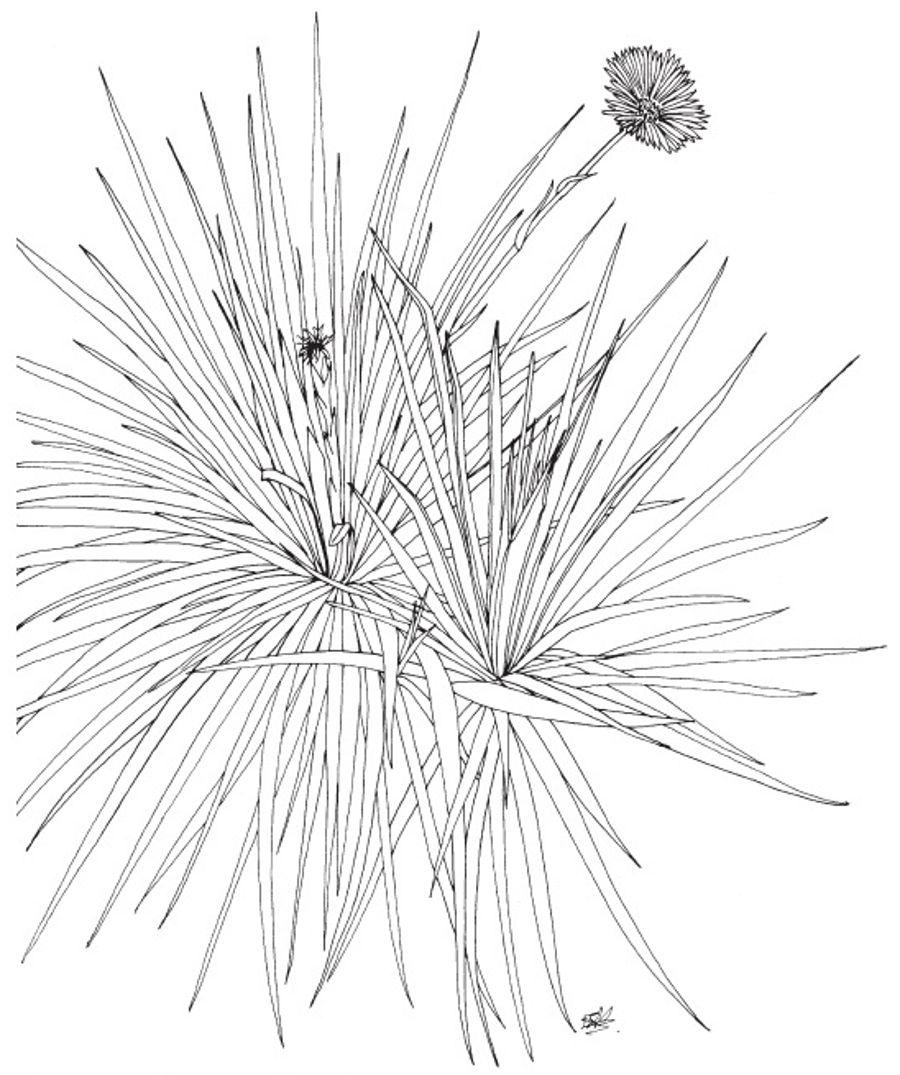 |
| Celmisia petriei. Illustration: Eleanor Burton. |
The track emerged into the open on a large area that has been cleared by a fire or a slip, and this extends to the bush line. The steep zigzag track had lovely patches of
Blechnum montanum, with beautiful bright red, new fronds.
The tarns at the top of the zigzag had some cushion plants in flower. These included
Donatia novae-zelandiae,
Kelleria croizatii,
Phyllachne colensoi, and the little moss-like rushes
Gaimardia setacea and
Centrolepis ciliata. It took a while to identify a small plant in the bog that looked like an
Abrotanella - the little umbelliferous
Actinotus novae-zelandiae. The gentians were not quite in flower, and the
Oreostylidium were mostly finished flowering. There were
Drosera arcturi and
D. spathulata in flower, some of which were quite tiny.
Further up, the subalpine scrub was interspersed with open tussock. Here the lovely
Hebe macrantha showcased its outsized flowers, against serrate leaves, and patches of
Dracophyllum menziesii provided patches of dark red.
Celmisia petriei, with its sword-shaped leaves, was common at higher altitudes. A few plants of the orchid,
Wairea stenopetala, were also in flower.
People who reached the true tops found woody vegetation, e.g.
Olearia arborescens, in large rock crevices where they were protected from browsing animals.
Gael Donaghy
Day 4, 2/1/11: Lake Mistletoe; Pleasant Bay
Day 5: 3/1/11: Borland Saddle / Mt Burns
We had another fantastic day, despite the ominous steady rain overnight which continued during breakfast and preparation time. However the previous day’s forecast proved itself with the rain having almost stopped by the time we reached Te Anau and the sky clearing to the south where we were heading. At Borland Saddle we met Professor Alan Mark and Dr Kath Dickinson.
Alan talked about the botany, ecology and geology of the area and also discussed the extensive research history of the site. A GLORIA monitoring site is located on the Mt Burns ridge. This is part of an international research project looking at climate change.
The beech forest we climbed through was dripping with the lichen,
Usnea articulata, and the trunks were covered with other lichens including the perforated
Menegazzia pertransida and
Pseudocyphellaria species.
Above the treeline we looked down to Pyramid Lake. The lake and surrounding lumpy landscape were formed by the huge Borland landslide, thought to be the largest in the world. The lake lies in a depression surrounded by red tussockland below the beech forest, i.e. an inverted treeline.
Mt Burns has a very rich flora. Of special note is the diversity of snow tussocks (7 species of
Chionochloa) and alpine daisies (18 species of
Celmisia).
Chionochloa teretifolia with its very hairy leaf margins was striking in the lower tussocklands, and higher up, two forms of
C. crassiuscula – a longer-leaved and a shorter one, which formed swards. All three of these have many curled leaves giving them a distinctive appearance.
We were treated to a lovely sunny day and little wind, allowing the party great botanising. Most of the group made it up to the upper, rocky, summit ridge (around 1600 m). We were also lucky with it being a very good flowering year. Plants putting on a great show included
Celmisia,
Chionochloa and
Aciphylla. Most impressive were the
Aciphylla:
A. lyallii,
A. pinnatifida,
A. congesta and
A. crosby-smithii on the way to the summit ridge. Also impressive was the flowering of
Ranunculus buchananii,
Dolichoglottis scorzoneroides and the tiny
Euphrasia integrifolia in the rocky valley below the summit.
Astelia linearis was putting on a good show with many jelly-bean fruits visible in the sward among the
Chionochloa. It was interesting to see
Grammitis poepiggiana growing in mats on rocks high up in the tussocklands.
The rich diversity of habitats provided for a rich flora. Major habitats included wetlands, shrub tussock, tussocklands, rockfields, herbfields, fellfields and rocky ridge / slope. The fellfields on the solifluction terraces along the upper ridge of Mt Burns are an interesting feature. The GLORIA site is located on these, and was chosen as it is the lower altitude limit for several alpine plants.
Some of the alpine plants flowering on these terraces, and the banks between them, were
Leptinella goyenii,
Raoulia hectorii,
Chionohebe ciliolota,
Celmisia hectorii,
C. sessiloflora,
Geum uniflora,
Kelleria croizatii,
Phyllachne colensoi and
Hectorella caespitosa. Lichens up here included the black, hairy
Gowardia nigricans and mats of brown
Cladia aggregata.
Alan and Kath were visiting the site to download a year of data from the four soil temperature and one air temperature dataloggers, which record the temperature each hour. The project now has eight years of records, with two more to go before the data is analysed. Brown creepers were active in the beech forest on the way down.
Brian Rance & Barbara Hammonds
Day 5: 3/1/11: Eglinton River delta; Boyd Creek
Those who decided to forgo the Mt Burns exodus settled on a trip closer to camp, to the mouth of the Eglinton River. Rain further west had greatly boosted river flows, so our hopes of exploring the shingly delta were curtailed. A churning, discoloured torrent discharged into the blue waters of Lake Te Anau, carrying with it small trees, branches and associated debris. Nevertheless we explored the river-side margins within reach, at first recording mostly adventives from this highly disturbed site, but also noting reddish clumps of
Carex buchananii, with a backdrop of
Phormium tenax in flower.
Probing further into the fringe of manuka, we discovered considerably more indigenous diversity than was first apparent. Seedlings and saplings of woody species included
Coprosma tayloriae,
C. rigida,
Carpodetus serratus,
Griselinia littoralis,
Pittosporum tenuifolium,
P. eugenioides,
Gaultheria antipoda,
Hebe salicifolia,
Dracophyllum longifolium,
Myrsine australis,
Lophomyrtus obcordata and
Olearia ilicifolia. Perhaps the most unexpected find was a few plants of fine-leaved parsley fern,
Botrychium biforme. By lunchtime our numbers had dwindled, seduced by the promise of lattes and cell-phone coverage in Te Anau.
The remainder returned to Boyd Creek, spending the afternoon investigating the beech forest margin near the access road to the camp. The creek is scenic and drops over a series of small cascades, with flowering
Hoheria glabrata extending out over the water. More
Botrychium generated interest, along with
Gastrodia orchids. Curiously, a few plants of the speargrass,
Aciphylla subflabellata, defended some grassy riparian clearings.
The final highlight of the day occurred back at camp at 10 p.m. when a bat swooped low and circled over the multitude of tents nestled amongst the beech and bog pine.
John Barkla
Day 6, 4/1/11: Boyd Tops Track
From the edge of Boyd Camp we set off through mountain beech forest encountering red and yellow mistletoe on the way, until we reached a large, open, bog area, a must-stop place returning memories of Middle Earth, and for some of the party the extent of the day’s trip.
Further on above the bush line lay a large basin backed by greywacke screes leading up to the southern summit of the Countess Range. The floor of the basin has extensive wetlands to the north side, and hummocky country in the south. The basin also contains a diversity of scattered wetlands and tarns.
Wetland species included:
Donatia novae-zelandiae,
Oreobolus pectinatus,
Dracophyllum prostratum,
Cyathodes empetrifolia,
Pentachondra pumila,
Abrotanella caespitosa and cushion bog.
The largest lake in the upper portion of the basin contains many interesting plants around its margin including
Deschampsia cespitosa,
Stenostachys laevis,
Isolepis basilaris,
Acaena fissistipula,
Rorippa palustris.
On the lower slopes, red tussock grew, and narrow-leaved tussock grew on the drier upper slopes.
Below the screes we saw snow totara, Coprosma cheesemanii, Drachophyllum rosmarinafolium, Gaultheria crassa, Olearia cymbifolia, Myrsine mummularifolia, Hebe odora and H. rakaiensis.
On the screes we found
Epilobium sp.,
Stellaria roughii,
Cardamine sp.,
Haastia sinclairi, and on the rocky summit
Hebe epacridea,
H. petriei,
Epilobium crassum,
Leptinella pectinata subsp.
willcoxii,
Chionohebe thomsonii and others.
Along the route through the beech forest the twitter and screech of many a bird accompanied us, including bountiful, twittering, rifleman, curious robin, shy tomtit, chattering kaka and screeching long-tailed cuckoo.
Margaret Herbert
Day 7, 5/1/11: Takahe Valley
We were fortunate to be given permission by DOC to visit Lake Orbell. The valley is gained by a steep climb through the forest from Lake Te Anau at the Te Anau glow-worm caves. Tunnel Burn, which drains Lake Orbell and forms the caves, disappears into the ground about half way down from the lake. The lake itself is below the bushline and is surrounded by a mixture of shrubland and red tussock grassland. There are some large limestone bluffs above the lake that are home to the limestone endemic
Chionochloa spiralis. There was not a lot of time for botanising that day as we had a boat to catch and were restricted as to where we could actually go, but it was a rare privilege being allowed to visit the valley. The takahe did not put in an appearance, but their distinctive droppings were all along the lake shore. My final plant of note is
Aciphylla takahea growing in
Hebe odora shrubland at the outlet of Lake Orbell.
David LyttleBotanical Society of Otago
Tony Aldridge reports that his “strongest impressions from the valley were the species of mistletoe from the landing up to the hut and lake, plus the persistent, and fresh, possum sign. To me the forest seemed to be in a state of tension. Can mistletoe and possum co-exist?”
He recalls:
• “a panax tree at the mouth of the Te Anau caves
• marine fossils as they crossed the river just before the hut
• abundant takahe droppings (Brian Rance thought the birds extruded several metres per day)
• counters on trees to mark progress to hut, and enabling the party to record vegetation changes
• painting on roof of hut – by local school art teacher?
• bottomless tea cup at base of track”.
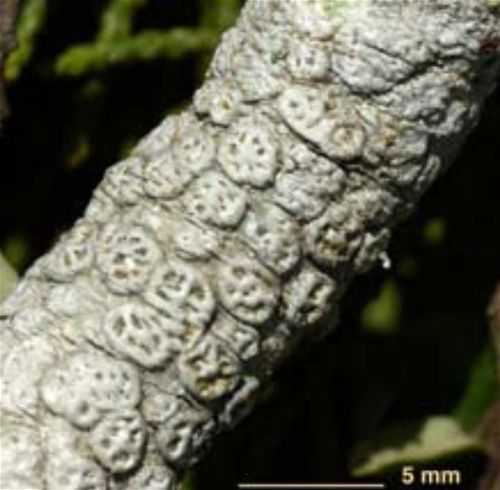 |
| Pertusaria southlandica growing on a twig of Nothofagus solandri among bog pine Halocarpus bidwillii beside the car park before the ford on the track to Boyd Creek Lodge. Photo Allison Knight. |
New species of lichen found
Recently published in
Australian Lichenology 69: pp33-35, July 2011, is a new species of corticolous lichen –
Pertusaria southlandica. A. Knight, Elix & A.W. Archer.
It was found by Allison Knight on the combined Wellington BotSoc and BotSoc of Otago camp at Boyd Creek, between Te Anau and Milford. Recognised by Allison as something different, the specimen was examined by experts on the genus in Sydney and Canberra. After visual and chemical comparisons with similar members of the genus, it was found to be a new species, then named for the district in the South Island where it was found.
Day 8, 6/1/11: Milford Sound
Driving to Milford Sound was appropriate for what was forecast to be a wet official last day of the camp. Most of the group opted to take the recommended 1.5-hour cruise to the Discovery Centre and Deep Water Observatory. After experiencing the famed Fiordland scenery in the rain: shrouded tops, thundering waterfalls and tantalising vegetation on sheer cliff faces, we observed some of its marine life from the observatory discretely located in a hidden bay. As a result of the high annual rainfall, and narrowness of the fiord, a layer of dark, fresh water accumulates over the sea, creating a deep ocean environment at a much shallower depth than usual (‘deep-water emergence’). A spiral staircase descends over 10 m to the viewing chamber from which we saw anemones, sponges and corals, including the delicate-looking black coral which appears white owing to its coating of other organisms, and fish species free to come and go.
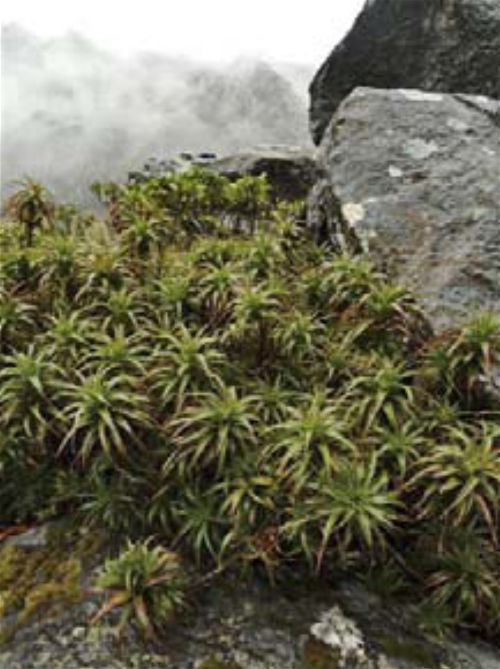 |
| Dracophyllum menziesii. Photo: Val Smith. |
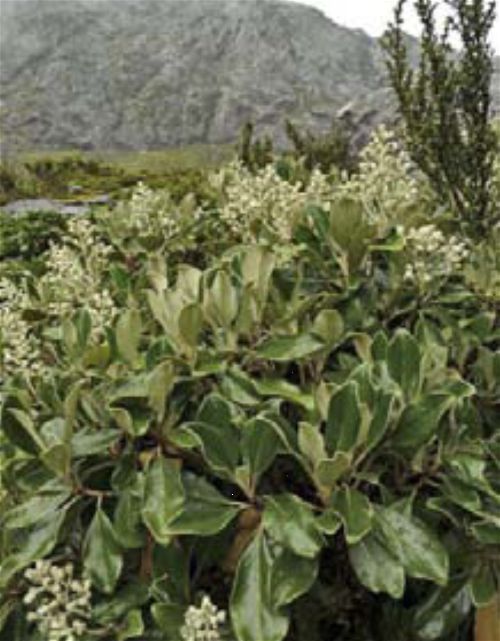 |
| Brachyglottis buchananii. Photo: Val Smith. |
The short Lookout Walk yielded the shrub
Archeria traversii with an accessible raceme of waxy pink flowers, which the photographers under their umbrellas tried desperately to record. The genus, which has about five species in Tasmania, and two endemic to New Zealand, is named after William Archer (1820-1874), a Tasmanian architect, politician, botanical artist and plant collector, who for two years assisted Sir Joseph Hooker at Kew. William Travers (1819-1903) collected in Nelson and Marlborough and helped establish the Wellington Botanic Garden.
On the way back to camp we joined the tourists at the Chasm Walkway on the Milford side of the Homer Tunnel, and managed to extend the stated 20-minute walk into more than an hour. The dramatic views and thunder of the swirling Cleddau River, and the dripping forest draped in ferns, mosses and lichens were overwhelming. In contrast, the East Homer Nature Walk at the eastern portal of the tunnel is an open alpine landscape of rock and scree carved from the surrounding mountains by glacial action – and we had it almost to ourselves! The names of many of the shrubs and herbs, such as
Archeria traversii earlier in the day, commemorate people, some of them well known to NZ botanists, and others less familiar. The large, glossy foliage of the giant buttercup,
Ranunculus lyallii, and the distinctive bronze, tapered leaves of pineapple scrub (
Dracophyllum menziesii) were easily recognised. Other species we saw included South Island leatherwood,
Brachyglottis buchananii (syn.
Senecio bennettii), low-growing, spreading
Coprosma fowerakeri (previously included in
C. pseudocuneata), the now rather rare
Astelia petriei, and the daisies
Celmisia walkeri,
C. du-rietzii and
C. bonplandii. It was an enchanting place in spite of (or perhaps because of) the rain.
Val Smith
Participants : Bev Abbott, Margaret Aitken, Tony Aldridge, John and Marilyn Barkla*, Robyn Bridges*, Barbara Clark, Dr Kath Dickinson, Gael Donaghy, Rewi Elliot, Dale Every, Ken and Julia Fraser, Ian and Jill Goodwin, Alyth Grant*, Bryan and Robin Halliday, Barbara Hammonds, Margaret and Richard Herbert, Chris Horne, Graeme Jane, Allison and John Knight*, Sheelagh Leary, Rodney Lewington, Stephen Lungley, David Lyttle*, Sir Alan Mark*, Barbara Mitcalfe, Kaaren Mitcalfe, Chris Moore, Syd Moore, Mick Parsons, Brian and Chris Rance*, Judy Russell*, Darea Sherratt, Barbara and Neill Simpson, Val Smith, Julia Stace, Carol West, Cathy Wylie.
* = Botanical Society of Otago.

 Site Index
Site Index







 Site Index
Site Index





